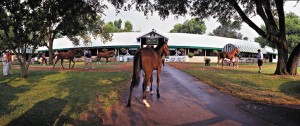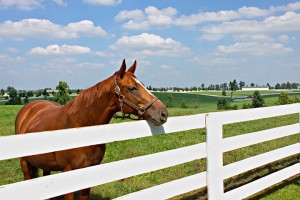Equine Industry
The equine industry is one of the largest industries in Central Kentucky, contributing billions of dollars to Kentucky’s economy each year.
The horse industry contributes $3.5 billion to our state’s economy. This signature industry is responsible for 96,000 jobs in the state, and more than 194,000 Kentuckians are involved in the business as horse owners, employees, and volunteers. $758 million of the $3.5 billion comes from the horse show industry.[1] Cash receipts from sales of horses and stud fees in Kentucky made equines the second most profitable agriculture product in 2009, according to state agriculture commissioner Richie Farmer. 2009 farm gate cash receipts totaled $4.26 billion. [2]
Our signature equine industry stretches far beyond farm-gate receipts, and into a wide-array of Lexington businesses. In 2010 there were 10,797 jobs directly associated with Kentucky’s Thoroughbred breeding industry and an additional 6,860 jobs indirectly related to this industry. For every $1 in earnings paid within the Thoroughbred breeding industry another $1.1 in earnings was paid in other industries within the economy. The 2010 estimated total earnings for the Thoroughbred breeding industry were $352.7 million.[3] This is incredibly important, as Lexington is a payroll tax community. Over 80% of our local government revenues come from payroll taxes.[4]
Today, Lexington is the Horse Capital of the World. This title is proudly displayed everywhere, from government stationary to local business slogans.
According to the Lane Report, “We have this honor because world-renowned horse farms, bloodstock companies, veterinary clinics, sales agencies, and racecourses are located here.”[5]
Thirty-Five national and international equine associations are headquartered at the Kentucky Horse Park. Lexington is also home to Keeneland and Fasig-Tipton, the two largest thoroughbred sales facilities in the world.[6] The 2011 fall sales at both Keeneland and Fasig-Tipton were both significantly stronger than the 2010 sales, with the average sale per horse up nearly 20%. The combined total of these two sales came to more than $261 million.[7]
Additionally there are 536 horse farms in the Bluegrass region, 183 of which are located here in Lexington.[8] With so many equine related businesses choosing Lexington as their home, it is no wonder that the title, “Horse capital of the world,” has become a slogan of local pride.
However, it’s not just about Thoroughbreds. Sport-horses are locating here from all over the world. Only 1/3 of the horses in Kentucky are thoroughbreds, the rest are Quarter Horses, Morgans, Warmbloods, and Arabians—a diverse range of breeds and disciplines. To further illustrate the importance of sport horses in our equine industry, in 2011 The Kentucky Horse Park hosted 14 national events, including the National Horse Show—the oldest in-door horse show in the United States. The combined economic impact of these events is estimated at $44.2 million.[9]
The equine industry has great cultural, natural, and economic significance for Lexington-Fayette County.
The thoroughbred industry, as reflected by the recent Keeneland, Fasig, and Saratoga sales, has stabilized. Projected foal crops will continue to decrease in an effort to “reduce supply” to “increase demand”…And this approach is working, as the average and sales price of each horse has increased 20-40% from previous years.[7] Lexington and the state of KY are still the epicenter of an international industry; Kentucky-based stallions accounted for 39.4% of the mares reported bred in North America in 2010 and 47% of the live foals reported for 2011.[10]
Additionally, In the fall of 2010, Lexington hosted the Alltech FEI World Equestrian Games. This honor was bestowed on Lexington because the equestrian plays a significant role the Bluegrass Region. More than half a million visitors attended the event bringing the unique beauty of the Bluegrass and its equestrian heritage to an international audience.[11]
1. (Return to text.)“Keeneland Head Worries About Death of Industry in It’s Job Capital” by Erik A. Carlson, Business Lexington, April 16, 2009
2. (Return to text.)USDA Economic Research Service 2009 Report
3. (Return to text.) “The Kentucky Thoroughbred Breeding Industry and State Programs That Assist the Equine Industry”, Program Review and Investigations Committee, Draft November 10, 2011
4. (Return to text.) LFUCG General Fund Budget, 2012
5. (Return to text.) “Market Review”, The Lane Report, 2007-2008
6. (Return to text.) “Hub of the Horse Industry,” The Lane Report, September 2010
7. (Return to text.) “Fasig Tipton Sale Posts Strong Increases Over 2010” by Alicia Wincze Hughes, Lexington-Herald Leader, November 2, 2011
“The Keeneland Fall Sale: A look at what happened” by Jeff Beach, Business Lexington, September 27, 2011
8. (Return to text.)Only farms registered with the Kentucky Thoroughbred Farm Managers’ Club are included these in numbers, meaning that the number of horse farms in our area may be much higher. Kentucky Thoroughbred Horse Managers’ Guide, 2011
9. (Return to text.) “National Horse Show Readies to Begin: Show caps post-WEG year that brought $44.2 million economic impact from 14 new equestrian events”, by Margaret Buranen, Business Lexington, November 1, 2011
10. (Return to text.) “As expected, 2011 foal crop numbers down” by Frank Angst, Thoroughbred Times, September 15, 2011
11. (Return to text.) Alltechfeigames.com
For more information,
“KY QHA-KY Horse Racing Authority”, Lexington Herald Leader, December 3, 2007.
“Strategies for Developing Agricultural Opportunities in the Greater Lexington Area”, Dr. Timothy A Woods, U.K. Department of Agricultural Economics, 2005




